Introduction
Rice-field rat (Rattusargentiventer) is one of the most important pests throughout the world. Rats can impact throughout cropping from seedling to harvesting stage, continues to post-harvest process in the storehouse (Priyambodo, 2009). Present chemical control for rodent pest species focuses mostly by using synthetic rodenticides. This technique is the most effective method and widely used to control rice-field rats (Sudarmaji, 2018). The rodenticides can also have undesirable side effects for non-target species and can also pollute the environment (Brown, Leung, Sudarmaji, & Singleton, 2003). Repellent, as an alternative chemical control of rice-field rats, can be less toxic and less harmful to the environment than rodenticides. The repellent application strategies by using effective chemical repellent are required to protect the resources from the damages caused by vertebrates (Werner, De Liberto, Baldwin, &Witmer, 2016). There have been many studies about plant secondary metabolites (PSMs) produce by several plant species that have potential as rodent repellents. Laboratory studies revealed that various groups of compounds, including essential oils and terpenoids, alkaloids, alkylamides, (di) carboxylic acids, glucosinolates, and phenolic, have been considered as a rodent repellent regarding by animal behavior/metabolism (Hansen, Stolter, Imholt, & Jacob, 2016).
Frangipani (Plumeriarubra), native to tropical America and belongs to the Apocynaceae family (Criley, 2005), has secondary metabolites in its several parts, one of them is in leaves. The methanol extract of frangipani leaves contains tannin, phlobatannin, saponin, flavonoid, steroid, terpenoids, cardiac glycoside, reducing sugar (Manisha &Aher, 2016), and also alkaloids (Utami, 2017). Frangipani has been reported in many studies as a plant-derived repellent for several insect species. Ramos, Araújo, Oliveira, Teixeira, and Pereira (2011) have previously reported that the sap of frangipani leaves has the potential as a repellent for beetle (Callosobruchusmaculatus) and leaf beetle (Zabrotissubfasciatus). Muthusamy (2014) also reported that the flowers of frangipani were found to have the potential as a repellent for mosquito (Aedesaegypti). The information about the potency of this species as plant-derived rodent repellents is unknown. The present study investigated the effects of methanol extract of frangipani leaves on metabolism, daily activity patterns, and its potency as a repellent of male and female rice-field rats.
Materials and methods
Study site: The experiments were conducted at Laboratory of Pests, Division of Pests Vertebrate, Department of Plant Pests and Diseases, Faculty of Agriculture, UniversitasPadjadjaran (6°35’32.72” S & 107°64’55.73” E) and Laboratory of Rats, Indonesian Center for Rice Research (6°55’33.0” S & 107°46’24.6” E), from February until May 2019.
Plant material: Young leaves were collected from along the roadside Moh, Toha highway, Bandung, West Java, Indonesia. The collected leaves were washed with tap water, air-dried for 2 weeks, and mashed with a blender into a powder for about 100 g.
Extraction and distillation: Powdered plant material (100 g) was subjected to 48 h extraction with 1 000 ml of 70 % methanol (MeOH). The ratio of plant materials and solvents were (1:10). The process of extraction (maceration) was practiced a 1 L beaker glass, covered with cling-wrap plastic film and aluminum foil, held in place with a rubber band. After the first 24 h, the crude extract was stirred with a spatula. The crude extract was filtered using a filter paper at the end of 48 h extraction. The distillation of crude extract after the extraction process was using automatic steam distillation (± 80 °C) for about 1.5-2 h. The result of the distillation process was 600 ml methanol extract of frangipani leaves in a liquid form. The extract was stored inside the refrigerator (± 2 °C) until used for the experiment.
Rice-field rat: The animals were initially supplied by the Indonesian Center for Rice Research (ICRR). Beforehand, it was collected originally from the closest rice-fields from ICRR by implementing LTBS (Linear Trap Barrier System). Healthy and mature 12 males (♂) and 12 females not pregnant (♀) rice-field rats with a range body weight between 90-130 g were chosen. The animal test was individually kept in aluminum-framed cages, adapted with food (brown rice) and beverage (tap water) under laboratory conditions for 7 days. Bodyweight changes and consumption of food and beverage of each animal test were daily measured for standard data.
Choice test: The effect of methanol extract of frangipani leaves for the choice test was observed by using the T-maze arena (Fig. 1) at the Laboratory of Rats, Indonesian Center for Rice Research. The arena of T-maze has 2 goals, left hand (A) was a treatment room with methanol extract of frangipani leaves and right hand (B) was a control room without methanol extract of frangipani leaves. The extract was sprayed onto 2 cloth sheets (10 x 10 cm) with a hand sprayer (5 ml/sheet) and placed inside room treatment (A) that close to food and beverage containers. Rice-field rat was individually kept in the T-maze arena, provided with food (brown rice 10 % of body weight) and beverage (100 ml of water), at the same amount both in the left hand and right hand of the T-maze arena, every day in the afternoon for 6 days experiment. The observations were carried out every day in the morning, including food consumption (g), water consumption (ml), bodyweight (g) and its changes (%).
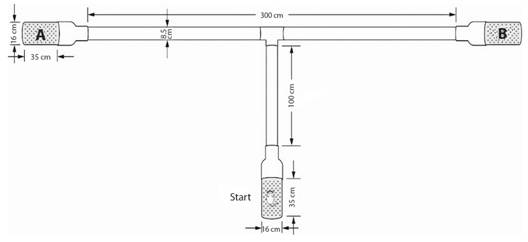
Fig. 1 The scheme of T-Maze arena. The arena has 3 sections: one start and two goals. A. Without methanol extract of frangipani leaves and B. with methanol extract of frangipani leaves.
No-choice test: The effect of methanol extract of frangipani leaves for the no-choice test was observed by using metabolic cage (Fig. 2) at the Laboratory of Pests, Division of Pests Vertebrate, Department of Plant Pests and Diseases, Faculty of Agriculture, UniversitasPadjadjaran. The extract was sprayed onto 2 cloth sheets (4 x 8 cm) with a hand sprayer (5 ml/sheet) and placed close to food and beverage containers. Rice-field rat was individually kept in a metabolic cage, provided with food (brown rice 10 % of body weight) and beverage (100 ml of water) every day in the afternoon for 6 days experiment. The observations for metabolic effects were carried out every day in the morning, including food consumption (g), water consumption (ml), feces production (g), urine production (ml), body weight (g) and its changes (%). Moreover, the daily activities of rice-field rats also observed coincide, including time spent for movement activities (locomotion), eating and drinking activities (foraging), and resting and sleeping activities (resting). The daily activities were observed by CCTV (Closed Circuit Television) and measured for 12 hours (18:00 h-06:00 h) to avoid disturbances on the animal test.
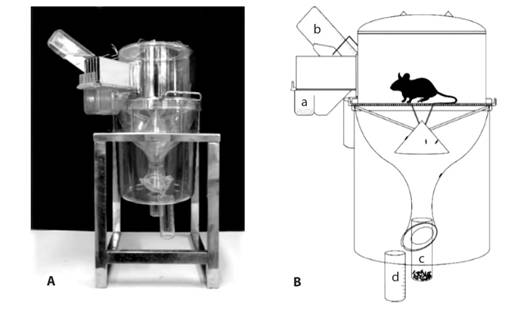
Fig. 2 Metabolic cages: A. Nalgene metabolic cage and B. the scheme of Nalgene metabolic cage was including containers for (a) food, (b) beverage, (c) feces, and (d) urine. Data processing and analyses: The treatments were done with 3 replications for both male and female rice-field rats, respectively. Data experiments from each treatment in the choice and no-choice test were analyzed using The IBM SPSS® software ver. 24.0 for Windows. When requirements for normality of data and homogeneity of variance were satisfied, the analysis followed by Student’s t-test for independent (unpaired) samples (Independent Sample T-test) or paired samples (Paired Sample T-test), assessed at 95 % confidence level to compare the differences between treatment means.
Results
Daily food and water consumption in the T-maze arena: The result showed that the food and water placed inside the control room (B) were highly significantly consumed than inside the treatment room (A). The average daily food and water consumption of male and female rice-field rats in the T-maze arena are summarized in Fig. 3 and Fig. 4, respectively.
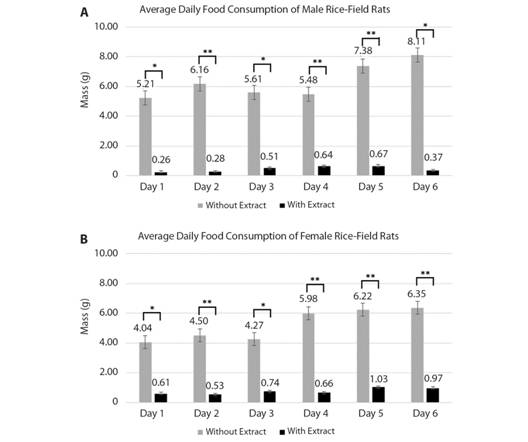
Fig. 3 Average daily food consumption of male A. and female B. rice-field rats, every day until six days of observation in the T-maze arena. Treatments were including with and without methanol extract of Plumeriarubra leaves. The standard error (SE) of the mean is shown by a vertical bar. (*) indicates a significant difference between treatments. *P < 0.05 = significant, **P < 0.001 = highly significant, according to Independent Sample T-Test (α = 0.05).
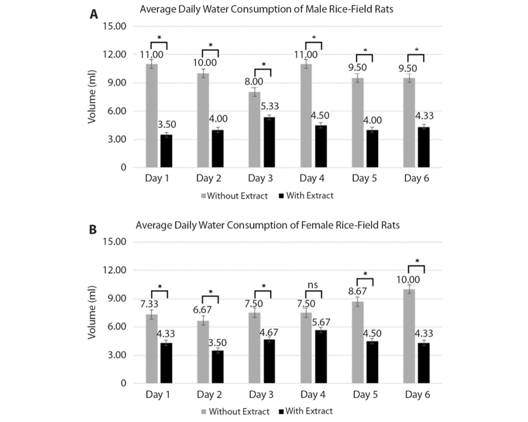
Fig. 4 Average daily water consumption of male A. and female B. rice-field rats, every day until six days observation in the T-maze arena. Treatments were including with and without methanol extract of Plumeriarubra leaves. The standard error (SE) of the mean is shown by a vertical bar. (*) indicates a significant difference between treatments. *P < 0.05 = significant, **P < 0.001 = highly significant, according to Independent Sample T-Test (α = 0.05).
Body weight and its changes in the T-maze arena: The results of body weight and its changes in male and female rice-field rats in T-maze are shown in Table 1. This study showed that there was a body weight decrease on average. During the experiment, the average body weight loss in male and female rice-field rats was 6.00 g about 5.13 %, and 8.66 g about 8.08 %, respectively. Based on the results of statistical analysis, the Paired Sample T-test on the average body weight changes of male and female rice-field rats in the T-maze arena, showed that the treatment of methanol extract of frangipani leaves has no significantly reduced body weight of male rice-field rats (P > 0.05). Otherwise, the same treatments have significantly reduced the bodyweight of female rice-field rats (P < 0.05). The optimal temperature and humidity for rats ranged from 24-26 °C and 40-70 %. However, the average temperature and humidity were higher during the experiment at Laboratory of Rats; Indonesian Center for Rice Research was 30.0 °C and 75.3 %, respectively.
Table 1 Average body weight (before and after treatment) and body weight changes of male and female rice-field rats after six days of observation in the T-maze arena
| Sex | Treatments | Body-weight (g) | Body-weight | |
| Before Treatment | After Treatment | Changes (%) | ||
| Male | With methanol extract of Plumeriarubra leaves | 116.67 | 110.67ns | -5.13 |
| Without methanol extract of | ||||
| Plumeriarubra leaves | ||||
| Female | With methanol extract of Plumeriarubra leaves | 107.33 | 98.67* | -8.08 |
| Without methanol extract of Plumeriarubra leaves |
(*) indicate a significant difference between before and after treatment on body weight (*P < 0.05 = significant, **P < 0.001 =highly significant, according to Paired Sample T-Test (α = 0.05).
Daily food and water consumption in the metabolic cage: The laboratory study revealed that both male and female rice-field rats in the metabolic cage without methanol extract (control) tended to consume highly significant of food with the range 8.63-11.26 g and extract frangipani leaves 5.63-8.19 g (Fig. 5). While in water consumption showed opposite results that both male and female rice-field rats tended to consume highly significant of water on extract frangipani leaf treatment with the range 9.00-12.67 ml than control 5.33-9.00 ml (Fig. 6).
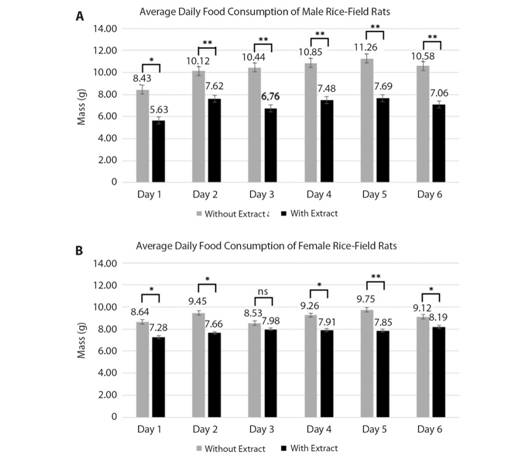
Fig. 5 Average daily food consumption of male A. and female B. rice-field rats, every day until six days of observation in the metabolic cage. Treatments were including with and without methanol extract of Plumeriarubra leaves. The standard error (SE) of the mean is shown by a vertical bar. (*) indicates a significant difference between treatments. *P < 0.05 = significant, **P < 0.001 = highly significant, according to Independent Sample T-Test (α = 0.05).
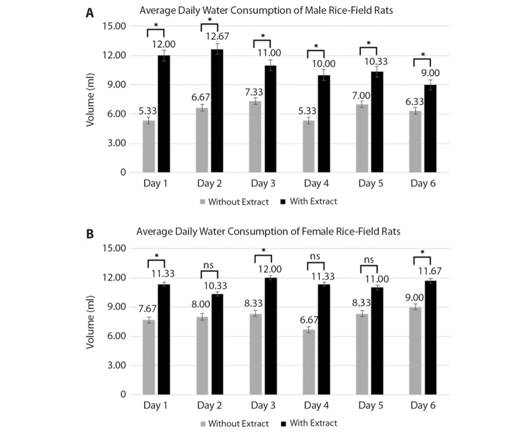
Fig. 6 Average daily water consumption of male A. and female B. rice-field rats, every day until six days of observation in the metabolic cage. Treatments were including with and without methanol extract of Plumeriarubra leaves. The standard error (SE) of the mean is shown by a vertical bar. (*) indicates a significant difference between treatments. *P < 0.05 = significant, **P < 0.001 = highly significant, according to Independent Sample T-Test (α = 0.05).
Feces and urine productions in the metabolic cage: The effects of methanol extract of frangipani leaves were also found in feces and urine production of male and female rice-field rats in the metabolic cage. The study in the metabolic cage without methanol extract of frangipani leaves showed that both male and female rice-field rats produced highly significant of feces than extract proven by the difference between 0.02-0.66 g (Fig. 7). The criteria of the feces were relatively the same, including round/oval, black-brown, and dry. Otherwise, in the metabolic cage with methanol extract of frangipani leaves, both the same animal test produced highly significant of urine than other treatments (Fig. 8). On the other hand, the study in metabolic cage methanol extract of frangipani leaves showed that both male and female rice-field rats produced highly significant of urine than without extract (control) by the difference between 2.24-3.67 ml.
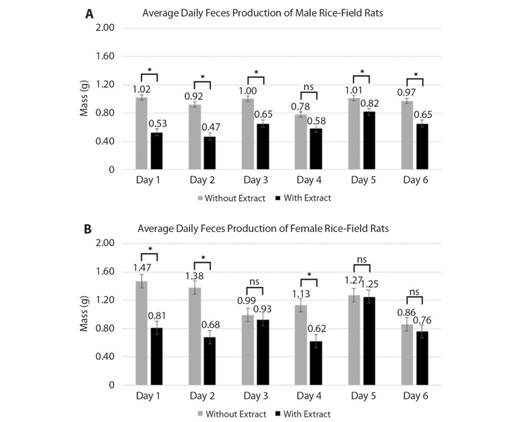
Fig. 7 Average daily feces production of male A. and female B. rice-field rats, every day until six days observation in metabolic cage. Treatments were including with and without methanol extract of Plumeriarubra leaves. Standard error (SE) of the mean is shown by a vertical bar. (*) indicate a significant difference between treatments. *P < 0.05 = significant, **P < 0.001 = highly significant, according to Independent Sample T-Test (α = 0.05).
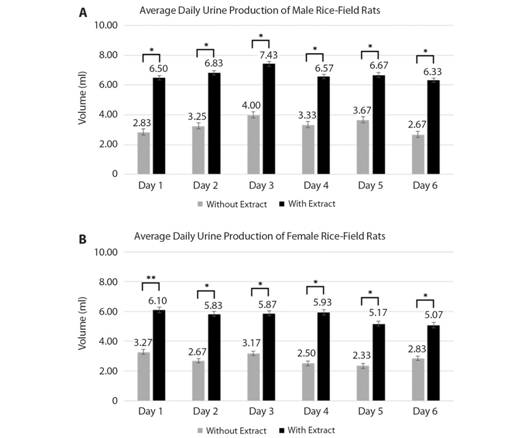
Fig. 8 Average daily feces production of male A. and female B. rice-field rats, every day until six days observation in the metabolic cage. Treatments were including with and without methanol extract of Plumeriarubra leaves. The standard error (SE) of the mean is shown by a vertical bar. (*) indicates a significant difference between treatments. *P < 0.05 = significant, **P < 0.001 = highly significant, according to Independent Sample T-Test (α = 0.05).
Body weight and its changes: Based on the body weight and its changes of male and female rice-field rats presented in Table 2, either with or without methanol extract of frangipani leaves in the metabolic cage has increased all of the animal test bodyweights. However, the body weight gain between male and female rice-field rats was quite different. The average body weight gain of male rice-field rats was higher in the metabolic cage without methanol extract of frangipani leaves (5.33 g about 5.05 % and 7.33 g about 6.18 %, respectively for each treatment), whereas on female rice-field rats the average body weight gain was higher in the metabolic cage with methanol extract of frangipani leaves (8.00 g about 7.03 % and 6.00 g about 5.46 %, respectively for each treatment). The results of statistical analysis, the Paired Sample T-test on the average body weight changes of male and female rice-field rats in the metabolic cage, showed that all treatments have significantly increased body weight of both male and female rice-field rats (P < 0.05). Otherwise, in accord with the Independent Sample T-test on the average body weight changes, showed that there was no-significant difference result between treatments (P < 0.05). However, the average of temperature 30.0 °C and humidity 75.3 % during the experiment at the Laboratory incompatible with optimal temperature and humidity (24-26 °C and 40-70 %).
Table 2 Average body weight (before and after treatment) and body weight changes of male and female rice-field rats after six days of observation in the metabolic cage
| Sex | Treatments | Body Weight (g) | Body Weight Changes | |
| Before Treatment | After Treatment | (%) | ||
| Male | With methanol extract of Plumeriarubra leaves | 106.00 | 111.33* | 5.05ns |
| Without methanol extract of Plumeriarubra leaves | 119.67 | 127.00* | 6.18 | |
| Female | With methanol extract of Plumeriarubra leaves | 113.00 | 121.00* | 7.03ns |
| Without methanol extract of Plumeriarubra leaves | 111.00 | 117.00* | 5.46 | |
(*) indicates a significant difference between before and after treatment on body weight and between treatments on body weight changes. *P < 0.05 = significant, **P < 0.001=highly significant, according to Paired Sample T-Test and Independent Sample T-Test, respectively (α = 0.05).
Daily Activity Patterns of in Metabolic Cage: The treatment of methanol extract of frangipani leaves caused daily activity patterns disorder on both male and female rice-field rats (Fig. 9). The results suggested that comparing between treatments (with and without methanol extract of frangipani leaves in the metabolic cage), both male and female rice-field rats were affected daily in their activity patterns such as locomotion, foraging, and nesting activity. According to Independent Sample T-Test, extract frangipani leaves showed a significant difference for locomotion and foraging activity, yet non-significant difference to nesting activity.
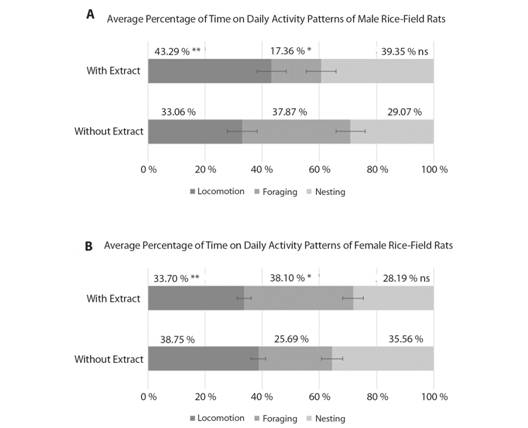
Fig. 9 The average percentage of time on daily activity patterns of male A. and female B. rice-field rats, every day until six days of observation in the metabolic cage. Treatments were including with and without methanol extract of Plumeriarubra leaves. The standard error (SE) of the mean is shown by a vertical bar. (*) indicates a significant difference between treatments. *P < 0.05= significant, **P < 0.001= highly significant, according to Independent Sample T-Test (α = 0.05).
Discussion
Daily food and water consumption in the T-maze arena: The result showed that the food and water placed inside the control room (B) were highly significantly consumed than inside the treatment room (A). The average daily food and water consumption of male and female rice-field rats in the T-maze arena are summarized in Fig. 3 and Fig. 4, respectively.
The Effects of Methanol Extract of Frangipani Leaves on Rice-field Rat in T-maze Arena: The methanol extract of frangipani leaves that are placed inside the treatment room may contribute as a repellent which caused that rice-field rats avoided to consume food and water that are close to the treatment. This suggestion is supported by Werner et al., (2016); wild mammals tend to change their behavioral responses, by avoiding their food that has been treated with chemical repellent. In this case, alkaloids and terpenoids that already contained in methanol extracts of frangipani leaves, reported by Manisha and Aher (2016) and Utami (2017), may be contributing to the effect, these chemical compounds have been known to be potential as a repellent material for rodents (Hansen et al., 2016).
It was found previously that both male and female rice-field rats in the T-maze arena were less to consume food and water. These results and due to the spacious space of the arena may be attributed to the average body weight loss. The effects may also have occurred because the temperature and humidity of the experimental environment were not suitable for the animal test. According to Richmond, Morton, and Hawkins (2007), environmental temperature and humidity can affect the health and behavior of rats.
The Effects of Methanol Extract of Frangipani Leaves on Metabolism and Daily Activity Patterns of Rice-field Rat in Metabolic Cage: In this study, we also found that rice-field rats continued to eat, either with or without methanol extract of frangipani leaves in the metabolic cage (no-choice test). It is important to note that the repellent effect by feeding the experiment will be more visible in the choice test but not in the no-choice test. This suggestion is supported by Hansen et al. (2016), due to the unavailability of alternative food sources in the no-choice test, the animal test will adapt slowly by eating food that already exists rather than starving, although it may be hazardous. These results could be caused by the treatment and might be induced by the secondary metabolites compounds in it, such as alkaloids and terpenoids; those have been reported by Hansen et al. (2016) to be potential as rodent repellent materials. These compounds may also evaporate in the metabolic cage and give excessive thirst anxiety on the rice-field rat.
The study in metabolic cage methanol extract of frangipani leaves showed that both male and female rice-field rats produced highly significant of urine than without extract (control) by the difference between 2.24-3.67 ml. According to Kurien, Everds, and Scofield (2004), collecting feces and urine of the animal test are an important step in the analyses of different metabolites and toxic products. However, the only method that can be used to collect feces and urine for 24 hours with controlling over food and drink consumption of the animal test is by using a metabolic cage, although this type of housing can become a stressful environment for animals (Tarland, 2007).
The methanol extract of frangipani leaves in a metabolic cage may accidentally be eaten by the animal test and contribute to the production of urine. This suggestion is supported by Ellepola, Deraniyagala, Ratnasooriya, and Perera (2015) and also Nurjanah, Samsuar, Nopiyansah, Lande, and Kanedi (2017), the amount of urine production in rats increased after the treatment of extractof Flueggealeucopyrusand ethanol extract of Euphorbia hirta, respectively by mixing it with the animal test drinking waters. This effect is thought to be related to several plant secondary metabolites disrupt of urine output (diuretics), including saponins, tannins, flavonoids, phenols, anthraquinones, alkaloids, and deoxysugar. Nevertheless, further analyses of the hormones corticosterone and immunoglobulin A (IgA) in feces and urine samples of rats need to be done to determine the level of stress and disruption of the animal test (Hunt &Hambly, 2006).
The body weight enhancement of male and female rice-field rats may be caused by the amount of food and water consumption that almost suitable with standard, according to Priyambodo (2009). Not only caused by the amount of food and water, but the bodyweight enhancement may also be affected due to the limited space of the housing arena.
Tahara, Aoyama, and Shibata (2017) have previously reported that behavioral changes in mammals are a physiological process that also depends on external environmental cues, including light/dark cycles, food intake, stress, and exercise. In this case, a housing rat in a metabolic cage can be a stressor. This type of housing may be commonly used for testing animals at the laboratory. However, this environment can affect behavioral changes that may lead to a negative emotional state such as causing stress in animals (Whittaker, Lymn, &Howarth, 2016).
Both male and female rice-field rats tend to spend more time on locomotion besides other activities. In contrast to this study result, Whittaker et al., (2016) reported that in a metabolic cage, rats will spend less time moving (locomotion). These results indicate that the methanol extract of frangipani leaves also may be causing stress for the animal test. Nevertheless, a combination of metabolic cage housing and the treatment would be assumed to become an extreme stressor that can change daily activity patterns for both male and female rice-field rats.
Overall, the methanol extract of frangipani leaves affects as a repellent and caused metabolic and daily activity patterns disorder of rice-field rats. Further research is required to identify and confirm the chemical compounds in methanol extract of frangipani leaves that responsible for all the effects. The repellent application strategies by using these plant materials must be explored more in order to incorporate into a pest management program.
Ethical statement: authors declare that they all agree with this publication and made significant contributions; that there is no conflict of interest of any kind; and that we followed all pertinent ethical and legal procedures and requirements. All financial sources are fully and clearly stated in the acknowledgements section. A signed document has been filed in the journal archives.












 uBio
uBio 

